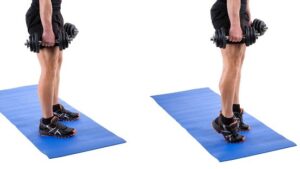Strength Training – Alternatives for the Pandemic
137
It may just be my imagination, but it seems to me that more and more runners over the past few years have embarked on some form of strength training. Perhaps it is the ever-increasing scientific evidence that this supplementary exercise regime plays a positive role in injury prevention and/or improved running performance that is responsible for inspiring so many to add this form of cross-training to their routine.
Very often, the primary method of strength training is a routine of weight lifting in a gym or fitness facility. With the current pandemic, however, many have had to forego their regular routine, as facilities were closed. Even now, as gyms are reopening (on a limited basis), many folks are reluctant to return to these facilities and so continue to miss out on what may be a very valuable and rewarding endeavor as they find it difficult to reproduce their programs at home.
Simulating upper body strength training exercises at home should not be that difficult. Exercises using hand weights or resistance bands, as well as body weight, can be done fairly easily and intuitively. Lower body strength training in your home, however, can be more challenging if you do not have weight machines designed specifically for the legs.
With this in mind, I would like to offer a few suggested exercises to as substitutes until you feel comfortable going back to the gym. The four exercises described below are designed specifically for runners, with the emphasis on promoting the optimal movement pattern of that activity.
Single-leg squat

This exercise is designed to work on the quads and gluteal muscles primarily. And, as you’ll notice, it closely simulates the running form. You only need to squat slightly (knee flexed 30o) to achieve that effect. Your knee should stay centered over the middle toe of your foot and not be allowed to drift inward. Ideally, you should be able to do this without holding onto the back of a chair or other object, but you should have it in front (or on the side) to steady yourself if you have difficulty staying stable and not wobbling.
There is an “incorrect” way to perform the squat, at least in terms of fostering the proper gait pattern for running, and it looks like this:

The squat should not be performed as a “sit-back” movement. Not only does this not mimic the running gait, it can put too much compression force to the back of the kneecap.
Standing Hip Abduction

The key to doing this correctly is the orientation of the movement. You should be bringing the lifting leg out to the side and slightly back; i.e., your right leg would be moving toward 3:30 if you were standing on a clock dial. (Left leg to 8:30). If you’re looking straight forward, you shouldn’t be able to see your foot with your peripheral vision. Use an elastic band tied tight above your knees for added resistance.
Hip Extension

To work your gluteals and hamstrings. Do as shown, using a band to added “weight.”
Calf Raises

Do with or without weights. Can be done one leg at a time for added difficulty and balance training.
Follow the general rule for all of these exercises – start slowly and conservatively and build up to greater resistance and repetitions.
